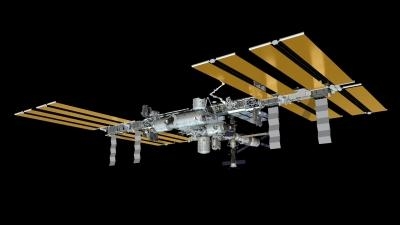Unfunded Partnerships Go To Four Companies
NASA has announced the selection of four U.S. companies to collaborate with NASA through unfunded partnerships to develop new space capabilities available to the government and other customers. The partnerships build on the success of NASA's commercial spaceflight initiatives to leverage NASA experience and expertise into new capabilities.

The Collaborations for Commercial Space Capabilities (CCSC) initiative is designed to advance private sector development of integrated space capabilities through access to NASA’s spaceflight resources and ensure emerging products or services are commercially available to government and non-government customers within approximately the next five years.
The companies selected for the Collaborations for Commercial Space Capabilities and their projects are:
- ATK Space Systems, in Beltsville, Maryland, is developing space logistics, hosted payload and other space transportation capabilities.
- Final Frontier Design, in Brooklyn, New York, is developing intra-vehicular activity space suits.
- Space Exploration Technologies, in Hawthorne, California, is developing space transportation capabilities that could be used to support missions into deep space.
- United Launch Alliance, in Centennial, Colorado, is developing new launch vehicle capabilities to reduce cost and enhance performance.
“Companies in all shapes and sizes are investing their own capital toward innovative commercial space capabilities,” said Phil McAlister, director of commercial spaceflight development at NASA Headquarters in Washington. "These awards demonstrate the diversity and maturity of the commercial space industry. We look forward to working with these partners to advance space capabilities and make them available to NASA and other customers in the coming years.”
The Space Act Agreements (SAAs) have no exchange of funds, and each party bears the cost of its participation. NASA's contributions could include technical expertise, assessments, lessons learned, technologies and data. Sharing this existing expertise in a structured way requires minimal government resources while fostering the development of technologies to enable NASA to achieve its strategic goal to expand human exploration of the solar system and to advance exploration, science, innovation, benefits to humanity, and international collaboration.
These collaborations are one of several NASA partnership initiatives with the commercial space industry. Others include the Lunar CATALYST initiative, which selected three companies for commercial robotic lunar lander capabilities, and the Asteroid Redirect Mission Broad Agency Announcement, which selected 18 proposals for studies related to NASA's plan to collect and redirect an asteroid, then send astronauts to collect samples.

These initiatives build on the successful legacy of NASA's current and previous commercial space activities, including the Commercial Orbital Transportation Services (COTS) initiative. Through COTS, two U.S. companies developed new rockets and spacecraft capable of providing cargo resupply services to the International Space Station. Similar initiatives are underway with commercial partners to develop human transportation capabilities for crewed flights this decade. On Sept. 16, NASA announced contracts with Boeing and SpaceX to develop and certify crew transportation systems that will carry astronauts from the United States to the space station and back on American spacecraft.
(Image from file)
 ANN's Daily Aero-Term (12.19.25): Ultrahigh Frequency (UHF)
ANN's Daily Aero-Term (12.19.25): Ultrahigh Frequency (UHF) NTSB Prelim: Cirrus Design Corp SR22T
NTSB Prelim: Cirrus Design Corp SR22T Classic Aero-TV: The Red Tail Project--Carrying the Torch of the Tuskegee Airmen
Classic Aero-TV: The Red Tail Project--Carrying the Torch of the Tuskegee Airmen Aero-News: Quote of the Day (12.19.25)
Aero-News: Quote of the Day (12.19.25) Airborne 12.17.25: Skydiver Hooks Tail, Cooper Rotax Mount, NTSB v NDAA
Airborne 12.17.25: Skydiver Hooks Tail, Cooper Rotax Mount, NTSB v NDAA




